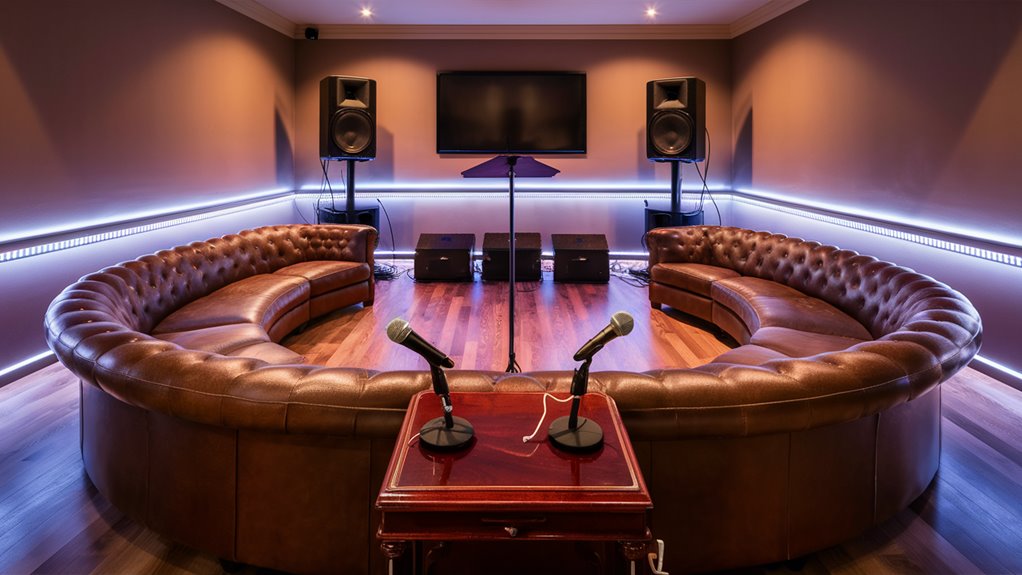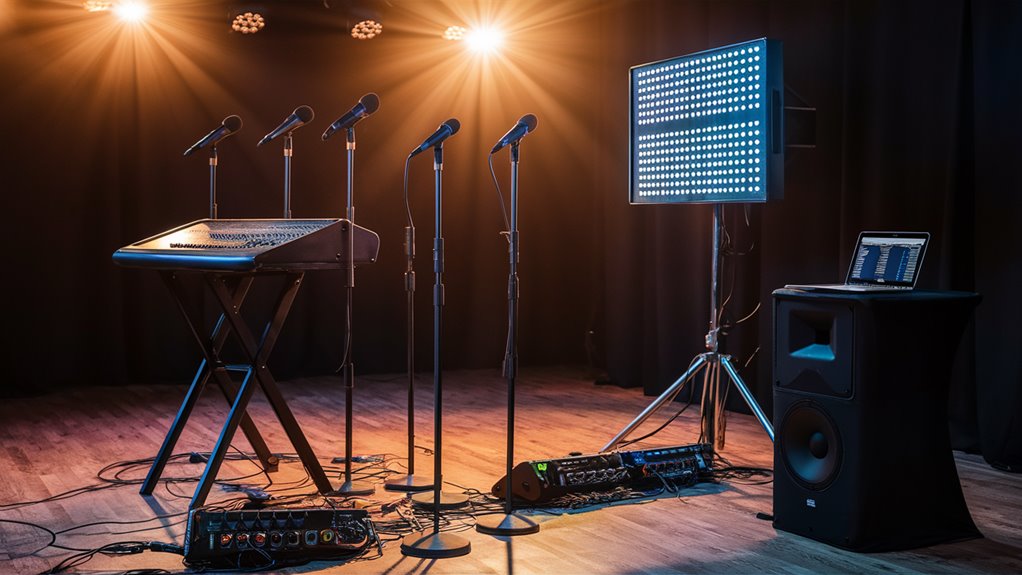How to Run the Best Karaoke Night

Set Up Great Sound
Good sound tools are key for a fun karaoke night. Put two speakers at 45-degree angles to move sound well. Keep sound levels between 85-90 decibels and aim for a 60:40 music-to-voice mix so singers can hear themselves and keep up with the music.
Choose Songs and Manage Playlist
Create a big song list with 100-150 chosen tracks. Add big hits from all styles and years, from old rock to new pop songs. Sort songs by ease, type, and time to suit all singing skills and likes.
Setting Up the Space and Mood
Set up your space with a clear stage area that takes focus. Use rows of seats to let all see well and be part of the show. Use the right lights at 2700-3000K color warmth to make a warm feel but keep lyrics easy to see.
Looking After Guests
Create a good line system to keep the show going. Offer group singing times to get shy guests to sing. Make a welcoming place by offering extra help and keeping a positive group rule.
Checking Tech Needs
Have great mics with the right settings to cut feedback. Keep song words clear on screens. Have extra tools ready, like spare mics and cables, to fix tech issues without pausing the fun.
Needed Gear and Setups
A pro karaoke setup needs the best gear for great sound. Begin with a top sound system with two speakers and a sub to keep audio even. Wireless mics are a must – get a two-mic set for duets and backups.
Digital Tools and Screens
Connect your karaoke center (a machine or PC) to pro karaoke apps with big song lists and updates. Use a two-screen setup with big TVs or projectors. One screen for the singer, one for the crowd, to make it fun for all.
Tech Mix and Safety
Add a pro sound mixer to keep the balance right between songs and voices. Plan your cables well with top plugs for smooth sound. Set up surge protectors and well-placed power lines to keep gear safe and stop tripping. Check the whole system an hour before to ensure it all works together.
Creating the Best Song List
Making a great song collection starts with 100-150 well-picked songs. Hit songs should cover many years and types to please guests. Include big sing-along songs like “Sweet Caroline,” “Don’t Stop Believin’,” and “I Will Survive” in any list.
Mastering Playlist Flow
Planning your songs needs thought for tempo and mood shifts. Balance fast tracks like “Sweet Home Alabama” with soft ones like “Killing Me Softly.” Choose from new hits, 80s rock, 90s pop, and old classics. Group your songs into:
- Party Starters
- Slow Songs
- Duets
- End Tunes
Choosing Songs for Your Crowd
Knowing your crowd is key for a good list. Work events need popular, clean songs, while young folks may want new pop and rap. Organize your songs by name, show full artist and title info. Mark hard songs to aid singers and keep shows smooth.
Tips for Better Sorting
- Group by type
- List BPM (beats per minute)
- Tag songs by energy
- Note changes in keys and voices
- See what songs are popular
Running the Singer Line
Good line control needs three main parts: easy sign-up, fair turn order, and clear talk rules. Use planned sign-up sheets with spots for singer info and song choices to keep things smooth and show the line order to keep it open.
Smart Turn Moves
The two-song break rule is a normal way to keep it fair. This means each singer waits for two others before going again. Using watched wait times and adding people in order when using several sign-up lists keeps it running well.
Talking Right in Lines

Keep the show smooth by naming the next three singers ahead. Have a ready singer plan for if a slot opens up. In busy times, use song time rules and stop repeats to let more sing.
Digital Line Aids
For big events, use automatic line-help systems that show:
- Live wait times
- Who’s up next
- Group Outing
- Easy sign-up from devices
- Slot watching
- Stop line fights
These digital tools make it run smooth and keep it fair for all singers.
Setting Up the Place
Smart place setup makes a pro karaoke night. Good gear spots and room planning turn simple places into top fun spots. Put your main screen where it’s easy to see, about 5-6 feet up, so all can see whether singing or watching. Place good speakers at 45 degrees up high, about 6-8 feet, aiming sound at the main singing spot for the best sound.
Making a Stage Area
Make a clear stage spot with good lights and easy view lines. The stage should be at least 6×8 feet, with:
- Safe floor materials
- Spot or focused lights
- Easy ways for singers to get on and off
- Room for two singers or a group
Where to Put Seats
Use a layered seat setup in a U-shape to keep all involved. Add:
- Tall tables (40-42 inches) around edges
- Normal tables (28-30 inches) in the middle
- Bar seats (if possible)
- Open paths with at least 36 inches clear
Lights for the Place
Room lights need careful picks for the best show:
- Install adjustable LED systems (2700-3000K color warmth)
- Keep it 50-70% bright for reading
- Create mood spots with extra lights
- Place work lights near the song pick spots
Always do a full sound test and gear check before starting.
Helping Shy Singers
Stage fear is real even for some who love to sing at karaoke nights. The trick to help is to make a place that cheers on nervous guests. Spotting shy singers early lets you cheer them on before the night gets going.
Ways to Build Up Courage
Singing with others is a great start for nervous singers. Seeing friends have fun together often makes one less scared. Picking the right song is very key – choosing tunes that match voice types and comfort zones really helps.
Key Moves for Singing Well
Using smart timing for shy singers helps them do well. The best time is after a few have sung well but before the place gets too loud. Getting the crowd going with cheers and claps makes everyone feel good. Having more ways to join like singing backup or in a group eases them into solo spots.
Helping Them Sing More
Getting from scared watcher to happy singer often starts with one good song. Singing with a friend gives help and tips. Once they sing once, they often return as regulars, growing the community of karaoke fans.
Sound Levels and Gear
Top sound quality and right volume control are vital for the best karaoke nights. Tests before the event must check all mics for clear sound and stop any feedback that could ruin the show.
Best Speaker Spots
Set main speakers at 70% max to adjust for how many are there and how the room sounds. Place speakers right at ear level, away from walls, to stop echoes. Keep a 60:40 music-to-voice balance to make sure voices are clear but the music still feels full.
Handling Sound and Tech
Use real-time sound checks with decibel apps to keep sound in the 85-90 dB range, good for impact but safe for ears. For wireless mics, have extra batteries and check for clear channels to dodge interference from other devices. Regular sound tests during the show make sure sound stays good and volume right.
Key Tech Info
- Speaker Height: At ear level
- Volume Range: 85-90 dB
- Sound Mix: 60:40 music to voice
- Max Gear Use: 70% power
Running the Show and Handling the Crowd
Good karaoke leading needs strong control of both singer fun and how the room feels. Using a clear sign-up system stops mix-ups and keeps the show smooth. Digital lines or simple clipboard plans work well when all can see them.
Keeping Energy Right
Handling room feel is a must for good nights. Watch the mood – put on slow songs to cool down too much fun or bring in group songs and lively bits to light up slow times. Handling tough times well, like dealing with drunk guests or very eager singers, keeps things on track.
Making It Open for All
Helping new singers is vital for long fun nights. Make a kind space where new folks feel they can join in. Make good plans for the show to handle long songs and repeats. Give quick thanks to singers, making the night better and everyone more into it.
Needed Tools for Managing
- Digital line tools
- Timing plans for singers
- Ways to handle the crowd
- Getting feedback
- Plans for quick fixes
